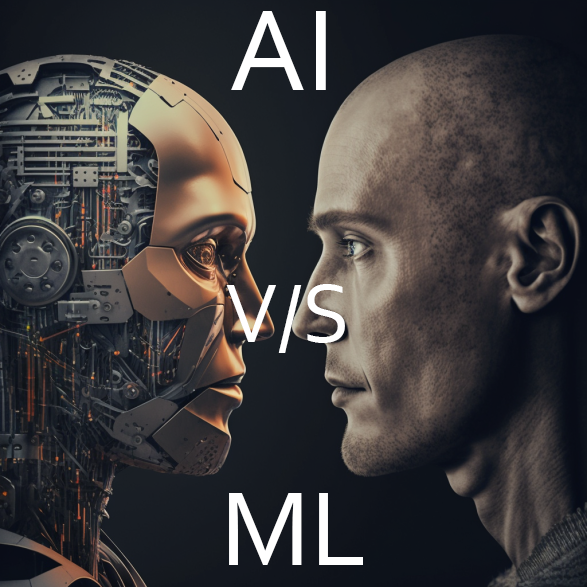Table of Contents
Introduction
This thorough guide to artificial intelligence (AI) and machine learning (ML), where we dig into the fascinating realm of intelligent technology, is your warm welcome. At AI Inject, we are passionate about helping businesses and individuals harness the power of AI to drive innovation, efficiency, and growth. In this article, we will explore the latest advancements in AI and ML, providing you with valuable insights and actionable knowledge.

Understanding AI and ML
Defining Artificial Intelligence
The creation of intelligent computers that can carry out activities that traditionally require human intelligence is referred to as artificial intelligence or AI. These tasks may include speech recognition, problem-solving, decision-making, and creative endeavors. AI systems can be categorized into two types: Narrow AI and General AI.
- Narrow AI: Also known as Weak AI, Narrow AI is designed to excel in specific domains or perform particular tasks. Examples include virtual assistants like Siri and Alexa, recommendation systems, and image recognition algorithms.
- General AI: General AI, also referred to as Strong AI, aims to exhibit human-level intelligence and possess the ability to perform any intellectual task that a human being can do. While General AI remains an ongoing area of research and development, significant strides have been made in various AI subfields.

Unraveling Machine Learning
Machine Learning is a subset of AI that focuses on the development of algorithms and models that enable systems to learn from data and improve their performance over time. Unlike traditional programming, where explicit instructions are provided, ML algorithms have the capacity to understand patterns and make accurate predictions or decisions based on the data they are trained on.
- Supervised Learning: In this approach, ML models are trained using labeled datasets, where inputs are associated with corresponding desired outputs. The model learns to map inputs to outputs, allowing it to make predictions on unseen data accurately.
- Unsupervised Learning: Here, the model is exposed to unlabeled data and is tasked with discovering underlying patterns or structures. Clustering and dimensionality reduction are common applications of unsupervised learning.
- Reinforcement Learning: In this paradigm, the model learns through interaction with an environment. It receives feedback in the form of rewards or penalties, enabling it to optimize its decision-making process over time.
AI and ML in Today’s World

Transforming Industries
The integration of AI and ML has revolutionized numerous industries, driving innovation and unlocking new possibilities. Let’s explore some key areas where AI and ML have made a significant impact.
Healthcare
AI and ML have the potential to revolutionize healthcare by enhancing diagnosis accuracy, improving treatment plans, and enabling personalized medicine. By analyzing vast amounts of patient data, these technologies can assist healthcare professionals in making more informed decisions, leading to better patient outcomes.
Finance
In the financial sector, AI and ML have proven invaluable in fraud detection, risk assessment, algorithmic trading, and customer service automation. These technologies enable institutions to analyze large datasets, identify patterns, and make real-time predictions, ultimately enhancing efficiency and reducing costs.

Transportation
The advent of autonomous vehicles and smart transportation systems owes much to AI and ML. These technologies power self-driving cars, traffic optimization algorithms, and predictive maintenance, making transportation safer, more efficient, and environmentally friendly.
E-commerce
AI-driven recommendation systems have transformed the way we shop online. By analyzing user preferences, purchase history, and browsing behavior, e-commerce platforms can deliver personalized recommendations, enhancing customer satisfaction and driving sales.
Google’s Free AI Course: Empowering the Masses

Recently, Google released a free AI course, signaling its commitment to democratizing AI education and making it accessible to a broader audience. The course covers fundamental AI concepts, including machine learning, neural networks, natural language processing, and computer vision. It provides learners with the opportunity to gain hands-on experience through practical exercises and real-world applications.
Course Highlights
- Introduction to AI: The course begins by providing a comprehensive overview of AI, its history, and its potential impact on various industries. Learners will gain a solid understanding of the core concepts and terminology associated with AI.
- Machine Learning Fundamentals: In this module, participants delve into the world of machine learning, exploring different types of learning algorithms and their applications. They will learn about data preprocessing, model training, evaluation, and optimization techniques.
- Neural Networks and Deep Learning: This module focuses on the fundamentals of neural networks, the building blocks of deep learning. Participants will gain insights into various neural network architectures and learn how to train and deploy them for different tasks.
- Natural Language Processing: NLP plays a vital role in enabling machines to understand and process human language. This module covers techniques such as sentiment analysis, named entity recognition, text classification, and machine translation.
- Computer Vision: Computer vision allows machines to interpret and understand visual information. Participants will learn about image classification, object detection, and image segmentation techniques. They will also explore advanced topics like convolutional neural networks (CNNs) and generative adversarial networks (GANs).
- Ethical Considerations in AI: Understanding the ethical implications of AI is crucial for responsible development and deployment. This module addresses topics such as bias, privacy, transparency, and accountability, empowering learners to build AI systems that align with ethical standards.
How to Make the Most of the Course

To fully leverage Google’s free AI course and enhance your understanding of the subject, we recommend the following strategies:
- Active Learning: Actively engage with the course materials, complete the exercises, and experiment with real-world datasets. This hands-on approach will solidify your understanding of AI concepts and enable you to apply them effectively.
- Collaborative Learning: Seek opportunities to discuss concepts and share insights with fellow learners. Participating in online forums or joining study groups can enhance your learning experience by exposing you to diverse perspectives and fostering collaboration.
- Real-World Projects: Apply the knowledge gained from the course to real-world projects. By working on practical applications of AI, you will develop a deeper understanding of how these technologies can be utilized to solve complex problems.
- Continuous Learning: Keep yourself updated with the latest advancements in the field of AI. Follow reputable sources, attend webinars, and explore research papers to stay at the forefront of this rapidly evolving domain.
How to join the course

This learning path is hosted on the Google Cloud platform. Click here to take any of the courses in the Generative AI Learning Path.
Remember that this isn’t the only free course available on the Google Cloud platform, but there are other cool courses like the Data Engineer Learning Path, Data Analyst Learning Path, etc. Click here to see the complete catalog in the Google Cloud Skill Boost.
FAQ’s
1. What is the difference between Artificial Intelligence (AI) and Machine Learning (ML)?
AI refers to the development of intelligent machines that can perform tasks requiring human intelligence, while ML is a subset of AI that focuses on enabling machines to learn from data and improve their performance.
2. How does Machine Learning work?
Machine Learning algorithms learn patterns and make predictions or decisions based on the data they are trained on. They can be trained using labeled data (supervised learning) or unlabeled data (unsupervised learning). Reinforcement learning involves learning through interaction with an environment.
3. How is AI being used in healthcare?
AI has numerous applications in healthcare, including enhancing diagnosis accuracy, improving treatment plans, and enabling personalized medicine. It can analyze large amounts of patient data to assist healthcare professionals in making informed decisions.
4. What role does AI play in finance?
AI is used in finance for tasks such as fraud detection, risk assessment, algorithmic trading, and customer service automation. By analyzing vast datasets, AI systems can identify patterns, make predictions, and optimize decision-making processes.
5. How has AI impacted the transportation industry?
AI has facilitated the development of autonomous vehicles, smart transportation systems, and traffic optimization algorithms. These technologies improve safety, efficiency, and environmental sustainability in transportation.
6. What is the significance of Google’s free AI course?
Google’s free AI course aims to make AI education accessible to a broader audience. It covers fundamental AI concepts, provides practical exercises, and empowers learners to gain hands-on experience in AI and ML.
7. How can I make the most of Google’s AI course?
Actively engage with the course materials, participate in collaborative learning, work on real-world projects, and stay updated with the latest advancements in the field to maximize your learning experience.
8. What are the ethical considerations in AI?
Ethical considerations in AI include addressing bias and ensuring privacy, transparency, and accountability in AI systems. Developing and deploying AI technologies responsibly and in accordance with ethical standards is essential.
9. What are some popular applications of AI and ML?
AI and ML are applied in various fields, including healthcare, finance, e-commerce, cybersecurity, autonomous vehicles, natural language processing, computer vision, and more.
10. How can I stay updated with the latest advancements in AI?
To stay updated, follow reputable sources, attend webinars, participate in AI communities, read research papers, and continuously engage in learning and exploration within the field of AI and ML.

Conclusion
In conclusion, AI and ML have transformed the way we live and work, revolutionizing industries and unlocking new possibilities. With Google’s free AI course, individuals from all walks of life can now gain valuable knowledge and practical experience in the exciting field of AI. From understanding the basics of AI and ML to exploring advanced topics like neural networks and computer vision, this course empowers learners to harness the power of intelligent technology.
By leveraging the insights gained from this course, individuals and businesses can drive innovation, enhance decision-making processes, and gain a competitive edge. AI and ML are not only shaping the present but also paving the way for a future where intelligent machines and human intelligence work hand in hand to tackle complex challenges.
So, dive into the world of AI and ML, explore the vast possibilities, and embrace the transformative potential of this cutting-edge technology. Equip yourself with the knowledge and skills to thrive in the age of intelligent machines and unlock new opportunities for growth and success.
Remember, the power of AI lies not only in its technological advancements but also in its responsible and ethical development and deployment. As we continue to witness the rapid evolution of AI, let us always strive for transparency, fairness, and the betterment of society. Embrace the power of AI and Machine Learning, and embark on a journey of innovation, discovery, and limitless potential.

3 thoughts on “Mastering AI and ML: Google’s Free Course Unleashes Power”